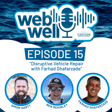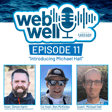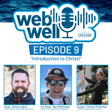
The WebWell Podcast, Episode 12 - "How does UX impact a Brand and build Trust?"
Welcome to the WebWell Podcast! In this episode, we have a special guest, Wyatt Gaines, joining us for a deep dive into the powerful relationship between User Experience (UX) and Brand. We'll explore how these two elements should collide to create trust and a lasting impression.
First, we'll introduce Wyatt and learn about his design background and what exciting projects he's currently involved in. Then, we'll share a little about how we know each other, with a nod to our local brewery experiences.
Our topic of the day is how UX significantly shapes a brand's image and fosters trust. To make sure everyone's on the same page, we'll start by defining UX and Brand, and we might throw in some simpler terms to keep things relatable.
Wyatt will share his experiences in using UX to support Brand, complete with some real-life examples. He'll also provide insights into how UX is evolving and what businesses should consider when strengthening the bond between UX and Brand.
As we wrap up, we'll discover what Wyatt is currently working on and what he hopes to tackle in the future. Plus, don't miss his shameless plug, where you can connect with him on Instagram at @wyatt.g.dsgnr and explore his portfolio at www.wyattg.com.
Stay tuned for another engaging episode, and remember, a seamless and thoughtful UX isn't just good design—it's the foundation of trust. This is the WebWell Podcast, and we're thrilled to have you with us.



















